


Tel: +86 189 6693 5266
Fax: +86 29 8263 6374
Skype: frankzhang051001
Wechat: frankzhang051001
WhatsApp: +86 189 6693 5266
QQ: 312813330
Email:
(Summary description)**Welding magnesium. **Magnesium is a white, very lightweight, machinable, corrosion resistant, high strength metal. It can be alloyed with small quantities of other metals, such as aluminum, manganese, zinc and zirconium, to obtain desired properties. It can be welded by most of the welding processes used in the metal working trades. Because this metal oxidizes rapidly when heated to its melting point in air, a protective inert gas shield must be provided in arc welding to prevent destructive oxidation. Magnesium possesses properties that make welding it different from the welding of steels. Many of these are the same as for aluminum. These are: Magnesium oxide surface coating, which increases with an increase in temperature. High thermal conductivity. Relatively high thermal expansion coefficient. Relatively low melting temperature. The absence of color change as temperature approaches the melting point. The normal metallurgical factors that apply to other metals apply to magnesium as well The welds produced between similar alloys will develop the full strength of the base metals; however, the strength of the heat-affected zone may be reduced slightly. In all magnesium alloys, the solidification range increases and the melting point and the thermal expansion decrease as the alloy content increases. Aluminum added as an alloy up to 10 percent improves weldability, since it tends to refine the weld grain structure. Zinc of more than 1 percent increases hot shortness, which can result in weld cracking. The high zinc alloys are not recommended for arc welding because of their cracking tendencies. Magnesium, containing small amounts of thorium, possesses excellent welding qualities and freedom from cracking Weldments of these alloys do not require stress relieving. Certain magnesium alloys are subject to stress corrosion. Weldments subjected to corrosive attack over a period of time may crack adjacent to welds if the residual stresses are not removed. Stress relieving is required for weldments intended for this type of service. Cleaning. An oil coating or chrome pickle finish is usually provided on magnesium alloys for surface protection during shipment and storage. This oil, along with other foreign matter and metallic oxides, must be removed from the surface prior to welding. Chemical cleaning is preferred, because it is faster and more uniform in its action. Mechanical cleaning can be utilized if chemical cleaning facilities are not available. A final bright chrome pickle finish is recommended for parts that are to be arc welded. The various methods for cleaning magnesium are described below. WARNING The vapors from some chlorinated solvents (e.g., carbon tetrachloride, trichloroethylene, and perchloroethylene) break down under the ultraviolet radiation of an electric arc and form a toxic gas. Avoid welding where such vapors are present. These solvents vaporize easily, and prolonged inhalation of the vapor can be hazardous. These organic vapors should be removed from the work area before welding begins.Dry cleaning solvent and mineral spirits paint thinner are highly flammable. Do not clean parts near an open flame or in a smoking area. Dry cleaning solvent and mineral spirits paint thinner evaporate quickly and have a defatting effect on the skin. When used without protective gloves, these chemicals may cause irritation or cracking of the skin. Cleaning operations should be performed only in well ventilated areas. Grease should be removed by the vapor degreasing system in which trichloroethylene is utilized or with a hot alkaline cleaning compound. Grease may also be removed by dipping small parts in dry cleaning solvent or mineral spirits paint thinner. Mechanical cleaning can be done satisfactorily with 160 and 240 grit aluminum oxide abrasive cloth, stainless steel wool, or by wire brushing. WARNING Precleaning and postcleaning acids used in magnesium welding and brazing are highly toxic and corrosive. Goggles, rubber gloves, and rubber aprons should be worn when handling the acids and solutions. Do not inhale fumes and mists. When spilled on the body or clothing, wash immediately with large quantities of cold water, and seek medical attention. Never pour water into acid when preparing solution; instead, pour acid into water. Always mix acid and water slowly. Cleaning operations should be performed only in well ventilated areas. Immediately after the grease, oil, and other foreign materials have been removed from the surface, the metal should be dipped for 3 minutes in a hot solution with the following composition: The bath should be operated at 70°F (21°C). The work should be removed from the solution, thoroughly rinsed with hot water, and air dried. The welding rod should also be cleaned to obtain the best results. Joint Preparation. Edges that are to be welded must be smooth and free of loose pieces and cavities that might contain contaminating agents, such a
(Summary description)**Welding magnesium. **Magnesium is a white, very lightweight, machinable, corrosion resistant, high strength metal. It can be alloyed with small quantities of other metals, such as aluminum, manganese, zinc and zirconium, to obtain desired properties. It can be welded by most of the welding processes used in the metal working trades. Because this metal oxidizes rapidly when heated to its melting point in air, a protective inert gas shield must be provided in arc welding to prevent destructive oxidation.
Magnesium possesses properties that make welding it different from the welding of steels. Many of these are the same as for aluminum. These are:
Magnesium oxide surface coating, which increases with an increase in temperature.
High thermal conductivity.
Relatively high thermal expansion coefficient.
Relatively low melting temperature.
The absence of color change as temperature approaches the melting point.
The normal metallurgical factors that apply to other metals apply to magnesium as well
The welds produced between similar alloys will develop the full strength of the base metals; however, the strength of the heat-affected zone may be reduced slightly. In all magnesium alloys, the solidification range increases and the melting point and the thermal expansion decrease as the alloy content increases. Aluminum added as an alloy up to 10 percent improves weldability, since it tends to refine the weld grain structure. Zinc of more than 1 percent increases hot shortness, which can result in weld cracking. The high zinc alloys are not recommended for arc welding because of their cracking tendencies. Magnesium, containing small amounts of thorium, possesses excellent welding qualities and freedom from cracking Weldments of these alloys do not require stress relieving. Certain magnesium alloys are subject to stress corrosion. Weldments subjected to corrosive attack over a period of time may crack adjacent to welds if the residual stresses are not removed. Stress relieving is required for weldments intended for this type of service.
Cleaning. An oil coating or chrome pickle finish is usually provided on magnesium alloys for surface protection during shipment and storage. This oil, along with other foreign matter and metallic oxides, must be removed from the surface prior to welding. Chemical cleaning is preferred, because it is faster and more uniform in its action. Mechanical cleaning can be utilized if chemical cleaning facilities are not available. A final bright chrome pickle finish is recommended for parts that are to be arc welded. The various methods for cleaning magnesium are described below.
WARNING
The vapors from some chlorinated solvents (e.g., carbon tetrachloride, trichloroethylene, and perchloroethylene) break down under the ultraviolet radiation of an electric arc and form a toxic gas. Avoid welding where such vapors are present. These solvents vaporize easily, and prolonged inhalation of the vapor can be hazardous. These organic vapors should be removed from the work area before welding begins.Dry cleaning solvent and mineral spirits paint thinner are highly flammable. Do not clean parts near an open flame or in a smoking area. Dry cleaning solvent and mineral spirits paint thinner evaporate quickly and have a defatting effect on the skin. When used without protective gloves, these chemicals may cause irritation or cracking of the skin. Cleaning operations should be performed only in well ventilated areas.
Grease should be removed by the vapor degreasing system in which trichloroethylene is utilized or with a hot alkaline cleaning compound. Grease may also be removed by dipping small parts in dry cleaning solvent or mineral spirits paint thinner.
Mechanical cleaning can be done satisfactorily with 160 and 240 grit aluminum oxide abrasive cloth, stainless steel wool, or by wire brushing.
WARNING
Precleaning and postcleaning acids used in magnesium welding and brazing are highly toxic and corrosive. Goggles, rubber gloves, and rubber aprons should be worn when handling the acids and solutions. Do not inhale fumes and mists. When spilled on the body or clothing, wash immediately with large quantities of cold water, and seek medical attention. Never pour water into acid when preparing solution; instead, pour acid into water. Always mix acid and water slowly. Cleaning operations should be performed only in well ventilated areas.
Immediately after the grease, oil, and other foreign materials have been removed from the surface, the metal should be dipped for 3 minutes in a hot solution with the following composition:
The bath should be operated at 70°F (21°C). The work should be removed from the solution, thoroughly rinsed with hot water, and air dried. The welding rod should also be cleaned to obtain the best results.
Joint Preparation. Edges that are to be welded must be smooth and free of loose pieces and cavities that might contain contaminating agents, such a
**Welding magnesium. **Magnesium is a white, very lightweight, machinable, corrosion resistant, high strength metal. It can be alloyed with small quantities of other metals, such as aluminum, manganese, zinc and zirconium, to obtain desired properties. It can be welded by most of the welding processes used in the metal working trades. Because this metal oxidizes rapidly when heated to its melting point in air, a protective inert gas shield must be provided in arc welding to prevent destructive oxidation.
The welds produced between similar alloys will develop the full strength of the base metals; however, the strength of the heat-affected zone may be reduced slightly. In all magnesium alloys, the solidification range increases and the melting point and the thermal expansion decrease as the alloy content increases. Aluminum added as an alloy up to 10 percent improves weldability, since it tends to refine the weld grain structure. Zinc of more than 1 percent increases hot shortness, which can result in weld cracking. The high zinc alloys are not recommended for arc welding because of their cracking tendencies. Magnesium, containing small amounts of thorium, possesses excellent welding qualities and freedom from cracking Weldments of these alloys do not require stress relieving. Certain magnesium alloys are subject to stress corrosion. Weldments subjected to corrosive attack over a period of time may crack adjacent to welds if the residual stresses are not removed. Stress relieving is required for weldments intended for this type of service.
Cleaning. An oil coating or chrome pickle finish is usually provided on magnesium alloys for surface protection during shipment and storage. This oil, along with other foreign matter and metallic oxides, must be removed from the surface prior to welding. Chemical cleaning is preferred, because it is faster and more uniform in its action. Mechanical cleaning can be utilized if chemical cleaning facilities are not available. A final bright chrome pickle finish is recommended for parts that are to be arc welded. The various methods for cleaning magnesium are described below.
WARNING
The vapors from some chlorinated solvents (e.g., carbon tetrachloride, trichloroethylene, and perchloroethylene) break down under the ultraviolet radiation of an electric arc and form a toxic gas. Avoid welding where such vapors are present. These solvents vaporize easily, and prolonged inhalation of the vapor can be hazardous. These organic vapors should be removed from the work area before welding begins.Dry cleaning solvent and mineral spirits paint thinner are highly flammable. Do not clean parts near an open flame or in a smoking area. Dry cleaning solvent and mineral spirits paint thinner evaporate quickly and have a defatting effect on the skin. When used without protective gloves, these chemicals may cause irritation or cracking of the skin. Cleaning operations should be performed only in well ventilated areas.
WARNING
Precleaning and postcleaning acids used in magnesium welding and brazing are highly toxic and corrosive. Goggles, rubber gloves, and rubber aprons should be worn when handling the acids and solutions. Do not inhale fumes and mists. When spilled on the body or clothing, wash immediately with large quantities of cold water, and seek medical attention. Never pour water into acid when preparing solution; instead, pour acid into water. Always mix acid and water slowly. Cleaning operations should be performed only in well ventilated areas.

The bath should be operated at 70°F (21°C). The work should be removed from the solution, thoroughly rinsed with hot water, and air dried. The welding rod should also be cleaned to obtain the best results.
Joint Preparation. Edges that are to be welded must be smooth and free of loose pieces and cavities that might contain contaminating agents, such as oil or oxides. Joint preparations for arc welding various gauges of magnesium are shown in figure 7-13.
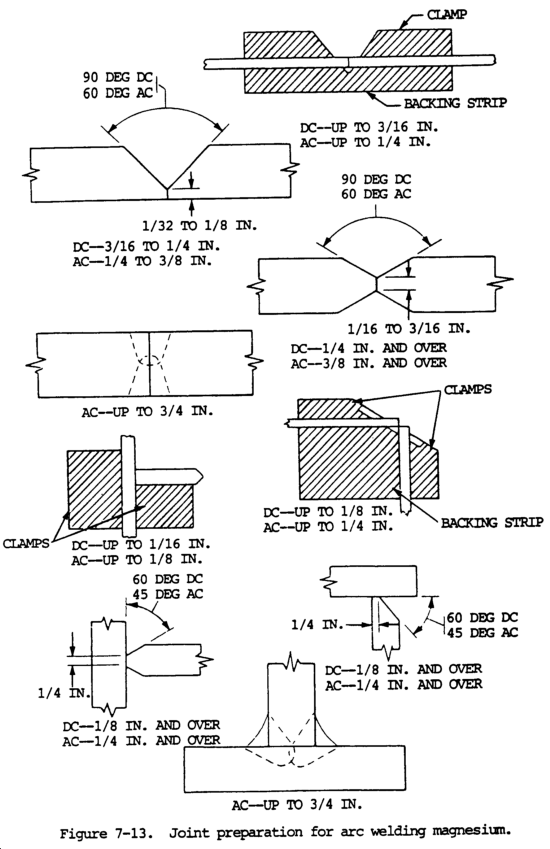
Safety Precautions
CAUTION
Magnesium can ignite and burn when heated in the open atmosphere.
The tungsten electrodes are held in a water cooled torch equipped with required electrical cables and an inlet and nozzle for the inert gas.
The two magnesium alloys, in the form of sheet, plate, and extrusion, that are most commonly used for applications involving welding are ASTM-1A (Fed Spec QQ-M-54), which is alloyed with manganese, and ASTM-AZ31A (Fed SPec QQ-44), which is alloyed with aluminum, manganese, and zinc.
In general, less preparation is required for welding with alternating current than welding with direct current because of the greater penetration obtained. Sheets up to 1/4 in. (6.4 mm) thickness may be welded from one side with a square butt joint. Sheets over 1/4 in. (6.4 mm) thickness should be welded from both sides whenever the nature of the structure permits, as sounder welds may be obtained with less warpages. For a double V joint, the included angle should extend from both sides to leave a minimum 1/16 in. (1.6 mm) root face in the center of the sheets. When welding a double V joint, the back of the first bead should be chipped out using a chipping hammer fitted with a cape chisel. Remove oxide film, dirt, and incompletely fused areas before the second bead is added. In this manner, maximum soundness is obtained.
The gas should start flowing a fraction of a second before the arc is struck. The arc is struck by brushing the electrode over the surface. With alternating current, the arc should be started and stopped by means of a remote control switch. The average arc length should be about 1/8 in. (3.2 mm) when using helium and 1/16 in. (1.6 mm) when using argon. Current data and rod diameter are shown in table 7-24.
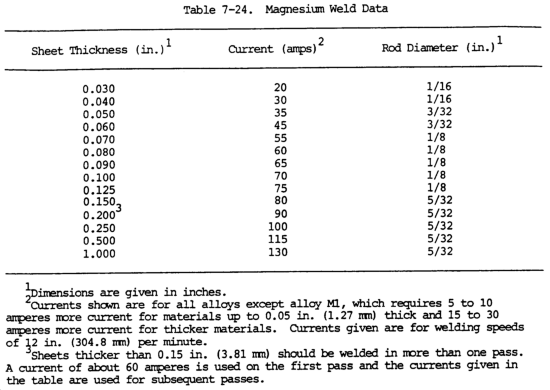
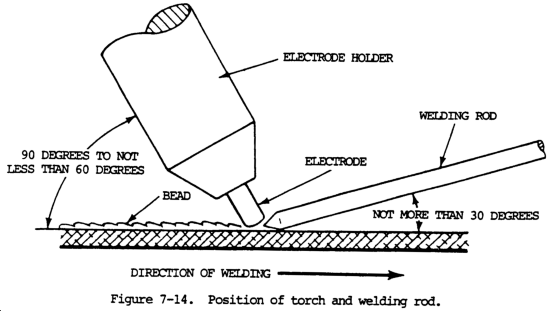
If cracking is encountered during the welding of certain magnesium alloys, starting and stopping plates may be used to overcome this difficult. These plates consist of scrap pieces of magnesium stock butted against opposite ends of the joint to be welded as shown in
A, figure 7-15. The weld is started on one of the abutting plates, continued across the junction along the joint to be welded, and stopped on the opposite abutting plate. If a V groove is used, the abutting plates should also be grooved. An alternate method is to start the weld in the middle of the joint and weld to each edge (B, fig. 7-15). Cracking may also be minimized by preheating the plate and holding the jig to 200 to 400°F (93 to 204°C) by increasing the speed of the weld.
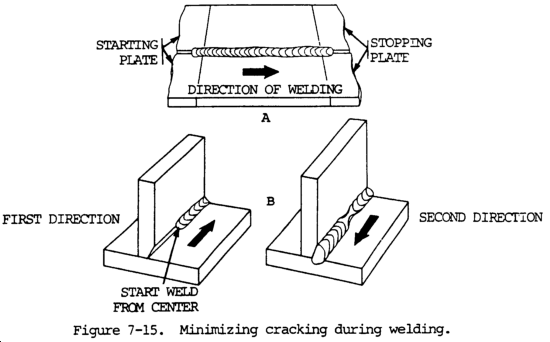

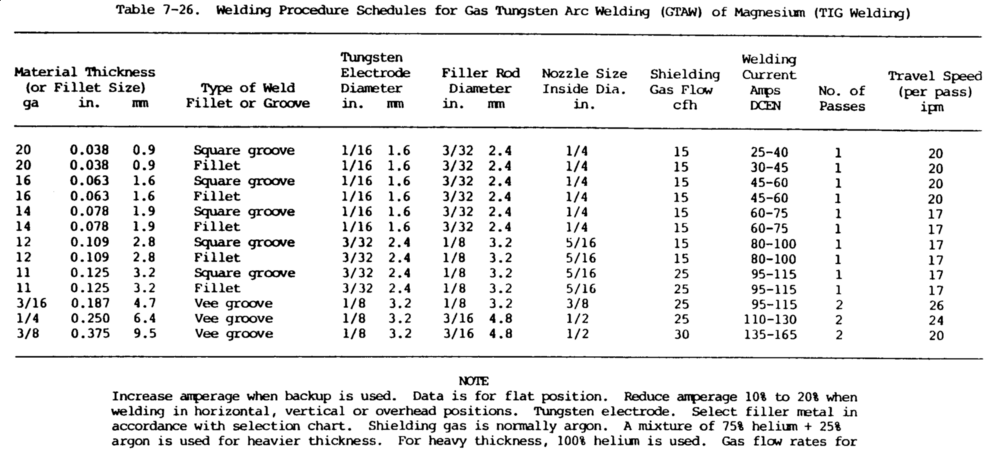
The MIG welding process is used for the medium to thicker sections of magnesium. It is considerably faster than TIG welding. Special high-speed gear ratios are usually required in the wire feeders since the magnesium electrode wire has an extremely high meltoff rate. The normal wire feeder and power supply used for aluminum welding is suitable for welding magnesium. Different types of arc transfer can be obtained when welding magnesium. This is primarily a matter of current level or current density and voltage setting. The short-circuiting transfer and the spray transfer are recommended. Argon is usually used for gas metal arc welding of magnesium; however, argon-helium mixtures can be used. In general, the spray transfer should be used on material 3/16 in. (4.8 mm) and thicker and the short-circuiting arc used for thinner metals. Welding procedure schedules for Gas Metal Arc Welding (GMAW) of magnesium (MIG welding) are shown in table 7-27.
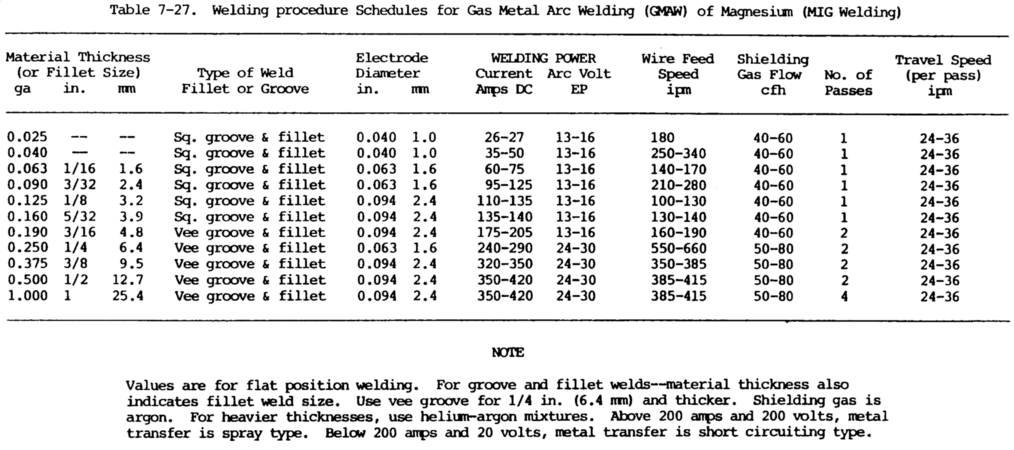 Other Welding Processes. Magnesium can be welded using the resistance welding processes, including spot welding, seam welding, and flash welding. Magnesium can also be joined by brazing. Most of the different brazing techniques can be used. In all cases, brazing flux is required and the flux residue must be completely removed from the finish part. Soldering is not as effective, since the strength of the joint is relatively low. Magnesium can also be stud welded, gas welded, and plasma-arc welded.
Other Welding Processes. Magnesium can be welded using the resistance welding processes, including spot welding, seam welding, and flash welding. Magnesium can also be joined by brazing. Most of the different brazing techniques can be used. In all cases, brazing flux is required and the flux residue must be completely removed from the finish part. Soldering is not as effective, since the strength of the joint is relatively low. Magnesium can also be stud welded, gas welded, and plasma-arc welded.
Xi'an Yuechen Metal Products Co., Ltd.
No. 2 Xinke Road, Xincheng Hi-Tech Industry Park,Xi'an 710043, Shaanxi, China
Tel: +86 189 6693 5266 Fax: +86 29 8263 6374 Skype: frankzhang051001
Wechat: frankzhang051001 WhatsApp: +86 189 6693 5266 Email: salesmanager@cnmagalloy.com
Website: www.cnmagalloy.com QQ: 312813330 陕ICP备18007848号-2 Powered by 300.cn 【MANAGER】
